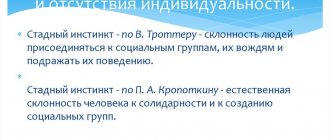Motivation and stimulation are the two main ways to influence employees to encourage coordinated actions aimed at achieving corporate goals. These concepts are often confused due to their similarity. And yet they are far from synonymous. There are fundamental differences between the terms, knowing which it is easier to competently organize a personnel management system.
Motive and motivation: what are the differences and similarities
To understand whether the concepts of “motive” and “motivation” are identical, you need to familiarize yourself with the psychology of personality. It is important to identify the differences and similarities between these definitions.
Motive is an internal engine that forces a person to perform certain actions. It is based on needs: security and material well-being, social recognition or self-expression. While the need is relevant, the person is trying to achieve the desired goal. If it is realized, then the level of activity of the individual decreases sharply or the movement stops completely until the moment the need is actualized again.
Motivation is a complex of factors that activates a person’s movement towards the fulfillment of a need, or the process of motivation itself.
When hiring staff, you can often hear candidates express their own motivation for joining the company, for example:
- “motivation is to earn enough money to ensure that my children attend private school”;
- “I want to work in a company because I can develop professionally in it and further make a career in my specialty”;
- “You need a job to earn money and open your own business.”
In each formulation there is a direction towards the goal (motivation), and in fact the need itself that must be satisfied (motive).
Definition
Motivation is a person’s conscious urge to be active, purposeful, and solve assigned problems. The desire is internal and manifests itself only when it is fully understood by the subject. Motivation is based on a certain need (physiological, spiritual, value), after which the impulse to action is significantly reduced.
Stimulation is a measure of external support that influences human activity. The main task of such a process is to accelerate management processes, induce the subject to perform the expected action, and change behavior. Incentives can be either positive (reward) or negative (threat of sanctions).
These concepts denote the processes of influencing a person’s personality, through which his behavior is programmed. However, motivation is characteristic of a specific person and is an internally conscious urge to action, while stimulation is an external influence. The distinction is fundamental to a number of sciences, including psychology and marketing. Incentives are a simple form of influencing a person, for example, providing a discount to a client when making a purchase.
To evoke internal motivation in a subject means to penetrate into his soul. Global brands form a special worldview among their customers, thanks to which the purchase of a new product becomes fundamental (remember Apple products, the functions of which practically do not change from model to model, and the army of fans is only growing). Thus, stimulation is just an impact on a person that continues as long as the process is active.
Motivation is an internal process that occurs individually. It will not end until the need is satisfied or replaced by another impulse to action. Incentives can be effective for a whole group of people, for example, employees of an enterprise. Additional incentives (vacation, bonuses) will help them work more actively and better for the benefit of the company. Most often, each person has his own motivation, and it is quite difficult to instill it.
Types of motives and work motivation of employees
All people work, coming to work with the goal of earning money. But why do two employees, equally professional, receiving the same salary, performing similar functionality, have different results of work? These people are driven by motives that may differ slightly depending on the needs of the person.
To understand this issue, it is important to understand what motives force a person to work:
- Achieving material well-being. What comes first is the need to receive a specific salary that allows the employee to realize his life goals.
- Receiving recognition for professionalism or contribution to the development of the organization. In this case, it is very important for the specialist to receive confirmation from the team and management of the significance of his role in the organization and the value of his professional results.
- Gaining experience and professional development. A powerful motive for young professionals and employees with little work experience, focused on development in the profession.
- Increasing social status and realizing personal ambitions. It occurs if an employee gets a job in a large corporation, and everyone around him in this case classifies him as a highly sought-after market specialist. Obtaining a prestigious management position may also be important.
- Involvement in the work of the team. It is important for those specialists who do not know how to work outside of a team, since they always need to be among people.
- Rivalry and gaining leadership positions. Workers with such a leading motive choose work in which they can demonstrate their organizational skills by competing with other people. They are often indispensable in sales departments, where the need to constantly be better than everyone else by selling more.
Differences
Some people believe that motivation and incentive are the same thing. However, this is far from the truth and the distinction between these concepts helps a person achieve his goals as efficiently and quickly as possible.
In fact, motivation is the inner core of a person, his world: beliefs, activity, interests, life principles, desires and needs. It is impossible to influence them. They are not susceptible to external manipulation.
A person himself strives to work and receives moral satisfaction from this. He doesn't care about bonuses or payments, he just goes to work and fulfills certain requirements. He has such a desire. A motivated person is disciplined, he always has a plan of action, he tries to achieve high results simply because he doesn’t know how to do it any other way and doesn’t want to.
He is satisfied with his own position, salary, place of work, team and everything else.
A stimulus is something like an external stimulus. Something that pushes a person to work. Thanks to bonuses and other rewards, the employer can influence the employee and increase the productivity of his work.
Incentives are not only material - for some, recognition in a team, praise from a boss or even family members is very important. In fact, both of these concepts have the same goal - to increase productivity, only global tasks fall on the shoulders of motivation, and stimulation helps solve these problems, somehow contribute to its occurrence and keep oneself in good shape.
In fact, both of these concepts have the same goal - to increase productivity, only global tasks fall on the shoulders of motivation, and stimulation helps solve these problems, somehow contribute to its occurrence and keep oneself in good shape.
For example, a person has just got a job and wants to get a position. This is his motivation, his inner impulse. Until he is hired, he is on a probationary period; an employment contract is an incentive to work productively.
Unlike motivation, incentives have a temporary effect. Sooner or later you forget about concluding a contract, as well as about an increase in salary, position, and so on.
Motivation is long-lasting, as it is based on the internal impulses and desires of the person himself. Of course, sometimes it can disappear, often due to stress, but after a short rest or proper rest it appears again. Naturally, if the employee continues to be motivated and enjoys his own working conditions.
Work motivation
The combination of motives creates certain types of work motivation of employees. In relation to the materiality of values that an employee would like to receive as a result of his work, three types of motivation are distinguished.
- Focus on material values. Employees with this type of motivation are focused on the amount of wages, the availability of additional payments and bonuses, the provision of compensation, and benefits. If there are changes in the company that result in a decrease in income or changes in benefits and compensation, the employee's performance may decrease.
- Focus on intangible values. For employees with this type of motivation, the very content of work tasks, their level of complexity, and the value of the result for the entire company are especially important. It is important for them to receive feedback on the results of their work and to receive an assessment of professionalism.
- A mixed type, in which both material values and intangible benefits are equally important to a specialist.
Based on their focus on achieving results, there are two types of work motivation that divide all employees into two categories: those who are aimed at achieving results and those who strive to avoid failure.
- Achieving success. These specialists are ready to solve problems and take responsibility. The fact of getting results and achieving success is important to them. If they cannot show successful results for a long time, they lose interest in what they are doing.
- Avoiding failure. These specialists do everything to make tasks either easier or within their capabilities. Failure avoiders are not ready to accept responsibility and are always afraid of making mistakes in their work.
Content
- Differences
- Scientific research
- How to motivate yourself and others
Hello dear readers. Sometimes awareness of certain points helps people to be successful and happy. You can look at your friends, colleagues, relatives and only envy how they reach such heights, where they get their motivation, how strong their willpower and self-confidence are.
What is the secret of these people? In today's article we will try to find out. You will learn the difference between stimulation and motivation, what results psychologists have achieved in their research on these issues, how to help yourself or your staff work more effectively, and much more, so sit back, let's begin.
Stimulus and the use of different types of stimuli
Motive and motivation are the internal driving force of human actions. A stimulus is an external stimulus that motivates a person to perform an action. The main objective of incentives is to influence the employee, as a result of which the speed or quality of work is increased. Incentives are divided into 2 main groups: material and intangible.
Material incentives include: 1. Incentives that have financial expression:
- wage;
- frequency of payments;
- availability of bonuses;
- surcharges for harmfulness;
- bonuses;
- compensation;
- reimbursement of communication and transport expenses;
- additional payment for length of service in the organization;
- payment of 13 wages.
2. Material incentives that do not have monetary expression:
- employee training at the expense of the company;
- provision of hostel and company car;
- discounted vouchers to holiday homes or sanatoriums;
- provision of health insurance;
- payment for housing at the expense of the company;
- provision of additional days for vacation.
Non-material incentives include: 1. Moral incentives that help realize human needs:
- awarding certificates and gifts;
- awarding titles;
- recognition as the best employee of the year;
- posting an article about an employee in a corporate publication.
2. Social incentives that activate the realization of social needs:
- providing opportunities for career growth;
- status of the position;
- friendly and friendly work team;
- participation in professional competitions.
3. Creative incentives that allow the employee to realize his creative potential at work:
- interesting work tasks;
- self-realization in the company's innovative projects;
- use of creative abilities when performing the functionality of the position.
What are these concepts?
First of all, it is necessary to understand the meanings of these concepts. What is motivation? You yourself feel the desire, enthusiasm and excitement to achieve your goals and objectives. This is an internal desire that arises when a person fully understands it.
What is the basis? You experience a physiological or psychological need. As soon as you satisfy it, the impulse begins to rapidly fade away.
Stimulation comes not from within, but from without. You receive external support that activates your enthusiasm.
The goal is to speed up management processes. By nature, it can be positive (for example, issuing bonuses or other monetary rewards) and negative (threat of dismissal or application of fines).
Principles of employee incentives
If a company begins to stimulate employees, then it must be remembered that an incentive applied once will give the same one-time result. Unsystematic incentives for staff will also not bring the required benefits.
For incentives to work and have a tangible effect, it is important to follow the basic principles:
- Stimulation should increase over time, gradually. A large number of preferences provided at once are depreciated because the employee did not make any effort to obtain them.
- The incentives used must be tangible and the employee must receive some benefit or experience the impact of the incentive, for example, when penalties are applied. If an employee’s salary is more than 50,000 rubles per month, and the fine for being late is 5 rubles for one delay, we can confidently say that the employee will continue to be late. The deduction amount of 105 rubles per month is not tangible for him.
- Combine material and non-material incentives. Employees should equally value financial rewards and managerial praise.
- Timeliness of incentives. If a large amount of time passes between the result for which reward should follow and the reward itself, the achievement is devalued.
- The relationship between incentive and motivation. The incentive must fall into the employee’s motivational coordinate system. If quiet work and clear job responsibilities are important to a person, and he is offered promotion and transfer to subordinate employees, then it is unlikely that such an appointment will motivate him to work further.
Why stimulation doesn't work
Firstly, due to the employee’s lack of internal and/or external motives that could motivate him to work.
Secondly, the stimulation may not have worked, since the incentive that you, as the boss, offered is diametrically opposed to the motives that the employee follows when performing a particular task. So, for example, an employee did not want to be on the honor roll - he was much more interested in a cash bonus.
In addition, you should pay special attention to the system of distribution of bonuses and cash incentives: it is likely that you are not entirely fair in this. An employee may wonder why he receives the same bonus as a colleague who works far fewer hours or is not doing his job conscientiously
Among other things, it is worth noting that incentives to work have a short-term effect, because very soon employees may get used to the incentives and do their work with less zeal. Your task at the moment of stimulation
– understand the internal and external motives of your employees, so that in the future, motivation and stimulation of work are combined and represent a common harmonious process.
Stimulate staff work
- not an easy task. However, you should study human psychology, in particular, your subordinates, in order to have an idea of what will help improve the work process and how best to do it. If you can find a competent and correct approach to your employees, very soon you will see that work efficiency has increased and you will be pleased with the results.
In this article we will look at how motivation differs from stimulation. In order for economic entities to function in a market economy, it is necessary to strengthen the phenomena under consideration.









